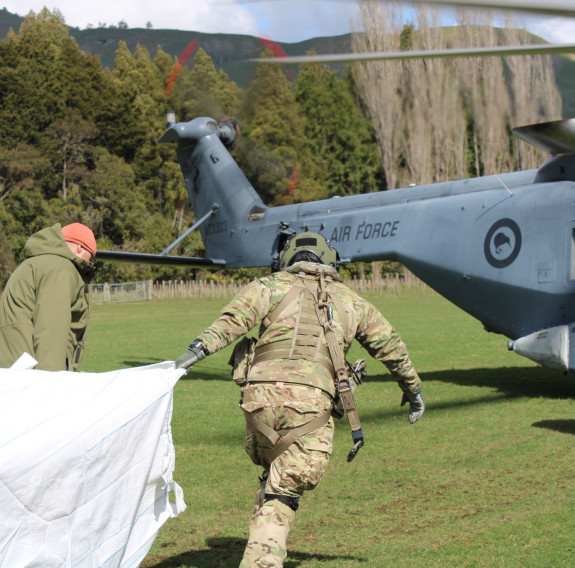RNZAF NH90 crew deliver record number of traps into Ruahine Range
The Royal New Zealand Air Force’s No.3 Squadron has delivered more than four tonnes of pest traps into the lower North Island’s Ruahine Range, the largest one-day back country delivery of traps in New Zealand conservation history.
19 September, 2023
The work supported the Department of Conservation - Te Papa Atawhai (DOC) and its pest control operations following the damage caused by Tropical Cyclone Gabrielle. Earlier this month, an NH90 helicopter and crew delivered 560 traps, weighing 4,400 kilograms. These traps, which target stoats, weasels and rats, will make a significant contribution to the protection of kiwi, whio (blue duck), robins, snails and rare plants.
Cyclone Gabrielle significantly affected the whio population by sweeping away current traps and introducing large amounts of gravel into rivers, reducing their food supply.
There are less than 3000 whio throughout New Zealand, with around 1000 North Island sub-species and around 100 breeding birds in the Ruahine Range.
DOC Principal Advisor Terrestrial Biodiversity Paul Jansen said the NH90 delivery was the single biggest lift of traps into the back country that the department has ever done in one day – around three times larger than the previous best.
“The biggest issue with these traps is their sheer weight and bulk. So the ability to lift those up in large amounts with a large helicopter certainly streamlined the operation,” he said.
“Because of the NH90 delivery, that trap network will now cover about 40,000 hectares of the Ruahines.”

Te Papa Atawhai and Mauri Oho staff load bags of pest traps into an NH90 helicopter to be dropped into the Ruahine Range as part of the re-establishment of the trapping network in the area

Te Papa Atawhai and Mauri Oho staff load bags of pest traps into an NH90 helicopter to be dropped into the Ruahine Range as part of the re-establishment of the trapping network in the area

Te Papa Atawhai and Mauri Oho staff load bags of pest traps into an NH90 helicopter to be dropped into the Ruahine Range as part of the re-establishment of the trapping network in the area

Te Papa Atawhai and Mauri Oho staff load bags of pest traps into an NH90 helicopter to be dropped into the Ruahine Range as part of the re-establishment of the trapping network in the area
Helicopter loadmaster Corporal Evan McKenzie said getting the bags into the aircraft was heavy work.
“They weighed up to 125kg each and we used the hoist to get them into the aircraft, but there still needed to be a bit of manhandling from the crew to get them in and out of the helicopter – I worked up a bit of a sweat,” he said.
“The beneficial thing about the NH90 is that we can carry a lot more than smaller civilian aircraft.
“It was pretty cool to be a part of. It was lots of work done in a short amount of time.”
With the traps delivered to drop off points in the bush, civilian helicopters will be used to disperse smaller bundles of traps to more remote areas.
Volunteers from groups such as Mauri Oho, the Whio Protectors, Ruahine Kiwi and DOC will then tramp through the bush to place them where they’re needed.
